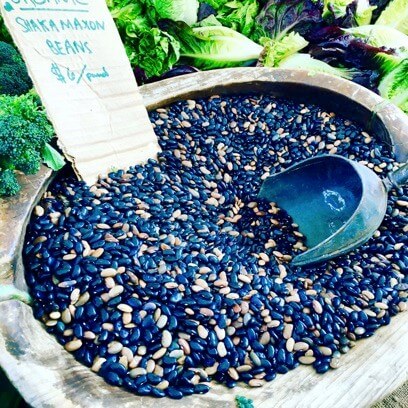Let Plant Proteins Shine

Putting more plant proteins—beans, lentils, soy foods, nuts, and seeds—on your plate offers myriad health benefits.
More and more people are interested in shifting their plate from animal proteins to plant proteins, including beans, soy foods, nuts, and seeds. In fact, a recent Mintel survey found that 36 percent of people are choosing meat alternatives, though only 7 percent identify as being vegetarian.
According to the Academy of Nutrition and Dietetics, you can gain many benefits from eating a more plant-based diet, including lowering your risk of cardiovascular disease, certain types of cancer, and obesity. In addition, you can lighten your footstep on Mother Earth by eating fewer animal foods, which require more inputs, such as fossil fuels, land space, and water, than plant foods. A semi-vegetarian diet has a 20 percent lower carbon footprint than a non-vegetarian diet, according to data from the Adventist Health Study 2.
Plant protein package. One of the advantages of choosing more plant-based proteins is their rich package of nutrients that come along for the ride, including healthy fats, fiber, vitamins, minerals, and phytochemicals—plant compounds that provide antioxidant and anti-inflammatory action, and may help protect from chronic disease. These benefits may be one of the reasons that plant-based diets are linked with lower disease risk.
Meat-heavy diets—especially red and processed meat (i.e., ham, sausage, and bacon)—were linked with increased mortality from cardiovascular disease and cancer in a long-term Harvard study. The data showed that replacing one three-ounce serving a day with more healthful protein options, such as nuts and beans, reduced mortality in the study period by 7-19 percent.
Plant protein quality. With so much interest in switching the plate from animals to plants, more focus is swirling around how to healthfully balance protein in the diet. “Most people in Western countries get more protein than they need and animal protein is not necessary to meet needs,” says Jack Norris, RD, a plant-based nutrition expert and co-author of Vegan for Life.
Animal proteins, such as meat, poultry, fish, dairy products, and eggs, are considered high quality, which means that they contain ample amounts of all nine essential amino acids—the building blocks of protein. Plant proteins may fall short in one or two amino acids, but if you eat a mixed diet with a variety of plant foods throughout the day you balance out those shortfalls, says health and nutrition researcher, Arianna Carughi, PhD.
One helpful measure is to know that “Plant proteins generally have the lowest percentage RDA per serving of the amino acid lysine. If a plant food meets the RDA for lysine, they are pretty much guaranteed to meet the RDA for all other essential amino acids,” says Norris. He suggests that most adults can meet lysine needs on a plant-based diet by eating lysine-rich plants, such as legumes, i.e., tempeh, tofu, soymilk, soy meats, beans, split or black-eyed peas, and peanuts, quinoa, seitan (a wheat protein food), pistachios, or pumpkin seeds.
Plant Proteins. Here are some common protein-packed plant foods to highlight in meal planning.
Food | Serving | Protein (g)
Almonds, 1 oz, 6 g
Black beans, cooked, ½ c, 8 g
Black-eyed peas, cooked, ½ c, 7 g
Chickpeas, cooked, ½ c, 8 g
Flaxseeds, 1 oz, 5 g
Hemp seeds, 1 oz, 9 g
Kidney beans, cooked, ½ c, 8 g
Lentils, cooked, ½ c, 9 g
Peanut butter, 2 Tbsp, 8 g
Pinto beans, cooked, ½ c, 8 g
Pistachios, 1 oz, 6 g
Pumpkin seeds, 1 oz, 7 g
Tofu, regular, ½ c, 10 g
Source: USDA; Note: g=gram, oz=ounce, c=cup, Tbsp=tablespoon
Tips for putting plant proteins on your plate. Even if you don’t want to become a vegetarian, you can reduce your animal protein intake in favor of more plant proteins more often as part of a wholesome plant-based diet pattern. Here are my top tips for powering up on plant proteins.
1. Swap breakfast meats for plants. Trade bacon and sausage for English-style baked beans, a scramble of diced tofu and vegetables, or peanut butter on toast.
2. Bean up your lunch. Swap chicken on your entrée salad for kidney or cannellini beans, fill your pita with hummus (made of garbanzos) instead of deli meat, or choose a bean burrito instead of beef tacos.
3. Snack on protein-rich plants. Turn to plant proteins, such as edamame, soy milk smoothies, and a handful of nuts for a satiating source of protein, fiber and slow-digesting carbs.
4. Love lentils. These plants, which do not require soaking, can be cooked up in about 20 minutes. Simmer lentils in stews or soups, sprinkle them in salads, and stir them in loaves and patties as the star of the plate.
5. Get nutty. Include an ounce of nuts, such as almonds, pistachios, and peanuts (technically a legume) each day as a protein source in salads, snacks, and side dishes.
6. Turn to soy. Plan meals around the protein-packed soybean. Dice tofu or tempeh (Indonesian fermented soy and grains) into stir-fries, casseroles, or soups; add soy beans to chili or stews, and slice baked tofu into sandwiches.
Sharon Palmer, RDN
Note: This article originally appeared in Environmental Nutrition


